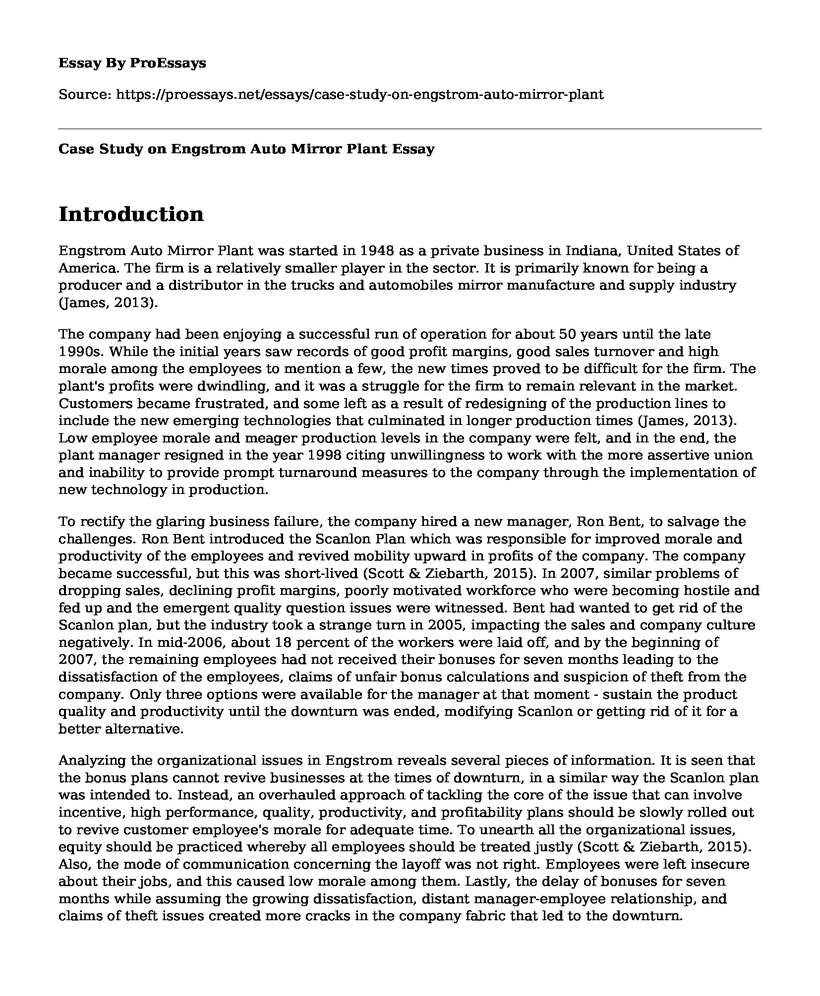Introduction
Engstrom Auto Mirror Plant was started in 1948 as a private business in Indiana, United States of America. The firm is a relatively smaller player in the sector. It is primarily known for being a producer and a distributor in the trucks and automobiles mirror manufacture and supply industry (James, 2013).
The company had been enjoying a successful run of operation for about 50 years until the late 1990s. While the initial years saw records of good profit margins, good sales turnover and high morale among the employees to mention a few, the new times proved to be difficult for the firm. The plant's profits were dwindling, and it was a struggle for the firm to remain relevant in the market. Customers became frustrated, and some left as a result of redesigning of the production lines to include the new emerging technologies that culminated in longer production times (James, 2013). Low employee morale and meager production levels in the company were felt, and in the end, the plant manager resigned in the year 1998 citing unwillingness to work with the more assertive union and inability to provide prompt turnaround measures to the company through the implementation of new technology in production.
To rectify the glaring business failure, the company hired a new manager, Ron Bent, to salvage the challenges. Ron Bent introduced the Scanlon Plan which was responsible for improved morale and productivity of the employees and revived mobility upward in profits of the company. The company became successful, but this was short-lived (Scott & Ziebarth, 2015). In 2007, similar problems of dropping sales, declining profit margins, poorly motivated workforce who were becoming hostile and fed up and the emergent quality question issues were witnessed. Bent had wanted to get rid of the Scanlon plan, but the industry took a strange turn in 2005, impacting the sales and company culture negatively. In mid-2006, about 18 percent of the workers were laid off, and by the beginning of 2007, the remaining employees had not received their bonuses for seven months leading to the dissatisfaction of the employees, claims of unfair bonus calculations and suspicion of theft from the company. Only three options were available for the manager at that moment - sustain the product quality and productivity until the downturn was ended, modifying Scanlon or getting rid of it for a better alternative.
Analyzing the organizational issues in Engstrom reveals several pieces of information. It is seen that the bonus plans cannot revive businesses at the times of downturn, in a similar way the Scanlon plan was intended to. Instead, an overhauled approach of tackling the core of the issue that can involve incentive, high performance, quality, productivity, and profitability plans should be slowly rolled out to revive customer employee's morale for adequate time. To unearth all the organizational issues, equity should be practiced whereby all employees should be treated justly (Scott & Ziebarth, 2015). Also, the mode of communication concerning the layoff was not right. Employees were left insecure about their jobs, and this caused low morale among them. Lastly, the delay of bonuses for seven months while assuming the growing dissatisfaction, distant manager-employee relationship, and claims of theft issues created more cracks in the company fabric that led to the downturn.
Some directions can be proposed to help resolve some of the issues that negatively impacted the Engstrom business. To begin with, the communication strategy must be well executed, and that is keeping the employees informed at all time and having team building functions. Had Bent and the top management done a better communication on the bonuses delay and the motivation plan, the workers would not have begun the claims which resulted in dissatisfaction and eventual low production, sales and profits (Newstrom, Davis, & Pierce, 1993). Also, appreciation and reward plans for the employees must be encouraged to bring about employee self-drive and innovativeness to work. The management must be open to ideas and be consultative to maintain its look like a fair and accountable body. Employees get motivated to work as a result.
Conclusion
In conclusion, to effectively manage workplace issues, there should be a close collaboration between the management and the employee body. Trust, accountability and a general feeling of equity should always be practiced by the management to avert unrest or sabotage of organizational plans by the employees due to dissatisfaction.
References
James, S. (2013). 300-04 Managerial Behavior.
Newstrom, J. W., Davis, K., & Pierce, J. L. (1993). Organizational behavior: Human behavior at work.
Scott, P., & Ziebarth, N. (2015). The determinants of plant survival in the US radio equipment industry during the Great Depression. The Journal of Economic History, 75(4), 1097-1127.
Cite this page
Case Study on Engstrom Auto Mirror Plant. (2022, Dec 16). Retrieved from https://proessays.net/essays/case-study-on-engstrom-auto-mirror-plant
If you are the original author of this essay and no longer wish to have it published on the ProEssays website, please click below to request its removal:
- Micro Language Policy for a Hotel Essay
- Discharged for Off-Duty Behavior Paper Example
- The Technology Employed by Tres Latin Foods Companies Paper Example
- Security Scenario Legal Applications Exercises Paper Example
- Essay Example on Employment Laws: Key Rules and Conflict Resolution
- Evaluation Essay on Apple Inc: Mission & Vision for Global Success
- Essay Example on Unlock Your Potential: How Governments Encourage Entrepreneurship







